Dusky Sharks live in the Indian, Pacific, and South Africa oceans. They are not endangered at this time. There has been some concern about their population size, but they are doing well and not endangered.
They are about 2 meters long. These species only come together to mate during their mating season, which is during the warmer months. These species like tropical seas for reproduction.
They usually don’t attack humans. They only attack if they feel threatened or if they think that the human is their food. The thing that they like to eat is fish, squid, shrimp, and other things like crabs and crustaceans (things with shells).
Dusky sharks are born in eggs in their mother’s body. These species live in water that is 10 m to 200 m deep. They can live up to 40 years old. They are not endangered now. They come together during mating season, and they do not live together all the time.
- Status: Vulnerable
- Known as: Dusky Shark, Dusky Whaler, Brown Whaler, Bay-shark, Dusky Ground Shark, Shovelnose, Bronze Whaler, and Brown Shark
- Estimated numbers left in the wild: 20% of levels in the 1970s.
Description of Dusky Shark

The Dusky Shark is a fairly large shark included in the requiem shark group. This shark species is related to the Silky Shark, Sandbar Shark, and Galapagos Shark. Requiem sharks are those that are most likely to be involved in attacks on humans, although the animal has instituted few of these. However, because the Dusky Shark inhabits waters often used by humans recreationally, the possibility of attack is still present.
In total, Dusky Sharks have been linked to six attacks on humans and vessels, three of which were indiscriminate and one of which resulted in death, according to the International Shark Attack File.
The female Dusky Shark is larger than the male, is between 320 centimeters and 420 centimeters in length, and can weigh up to 180 kilograms.
Males usually top out at around 150 kilograms. These sharks are bronze/grey to slate or dark slate on their dorsal surfaces and white beneath. They have a rounded shark snout with an impressively toothed mouth opening below.
Distribution and habitat
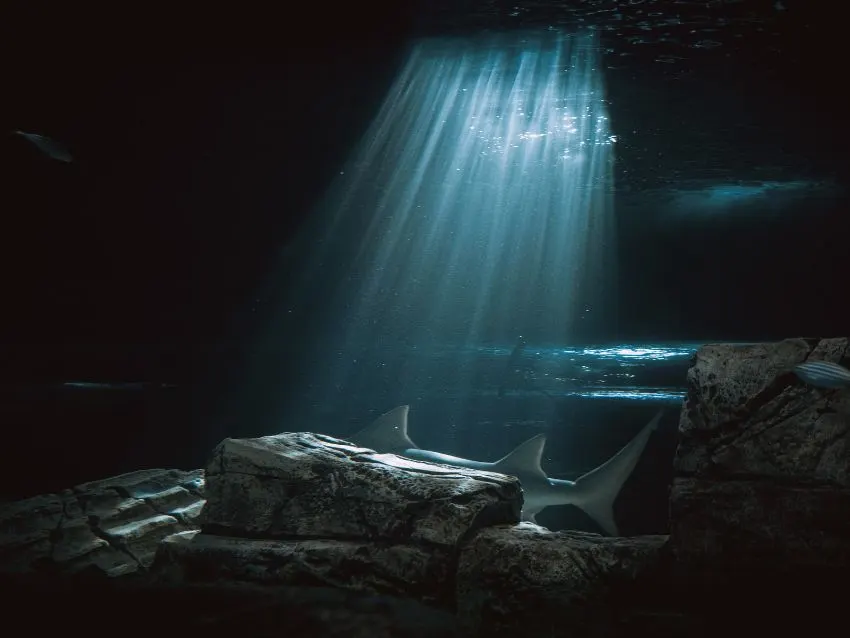
Dusky Sharks prefer warm waters and will migrate from more temperate regions when colder weather arrives. They have been known to migrate for great distances, up to 3,200 kilometers.
These sharks are very sensitive to the salinity of the water and will avoid estuaries where fresh water may be mixed with salt.
Although these sharks are most common on the continental shelves adjacent to landmasses, they will venture into deeper water near the drop-off point of the shelves.
See Related: Types of Sharks Around the World
Feeding
Dusky Sharks take a wide variety of prey, including bluefish, octopuses, squid, groupers, skates, mullet, sharks, and herring. They will also eat refuse that has been dumped into the ocean.
Breeding
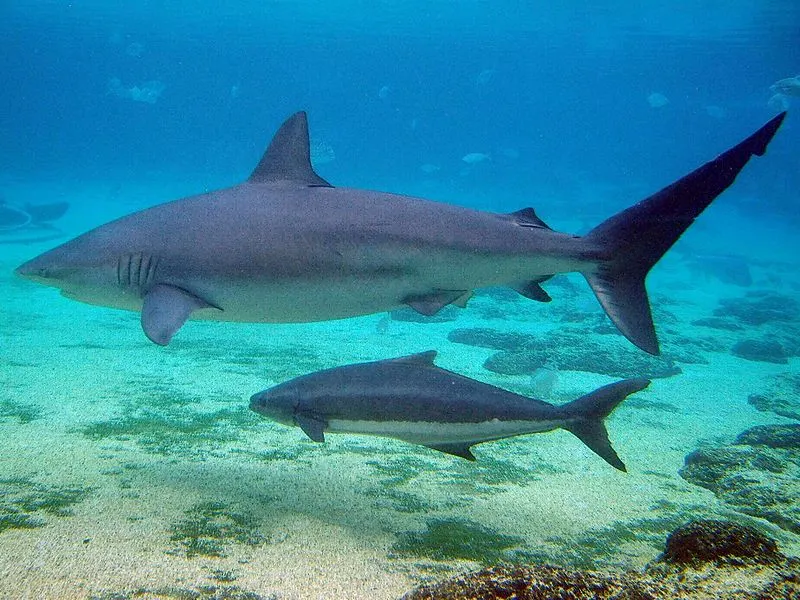
Springtime is when Dusky Sharks mate and the gestation period is about 8 months. The embryo sharks initially receive nourishment from a yolk sac, but when this has been used up, a placental attachment with the mother’s body is made.
The newborn Dusky Shark is approximately 1 meter at birth, and it takes the female a year to recover from the ‘pregnancy’ before she is ready to mate once again. A litter will consist of between 6 and 14 young. These sharks can live up to 50 years.
Fun fact: Female Dusky Sharks may retain sperm when they do not encounter possible mates frequently.
Location
The Dusky Shark has a worldwide distribution along continental shelves. They are found along the Atlantic coast from Maine down to Argentina. On the Pacific side, Dusky Sharks live along the California coast. They surround Australia and live around the coastal regions of most of Africa.
They can be found in great numbers in the seas of the western and central Mediterranean, the Atlantic Ocean, the Atlantic Ocean, the Atlantic Ocean, the Canary Islands, Senegal, Sierra Leone, and even the waters of Spain, Portugal, Madeira, and Morocco. They are occasionally spotted in the Arabian Sea, the Red Sea, and the Bay of Bengal. They also populate the great Pacific Ocean.
About the Dusky Shark
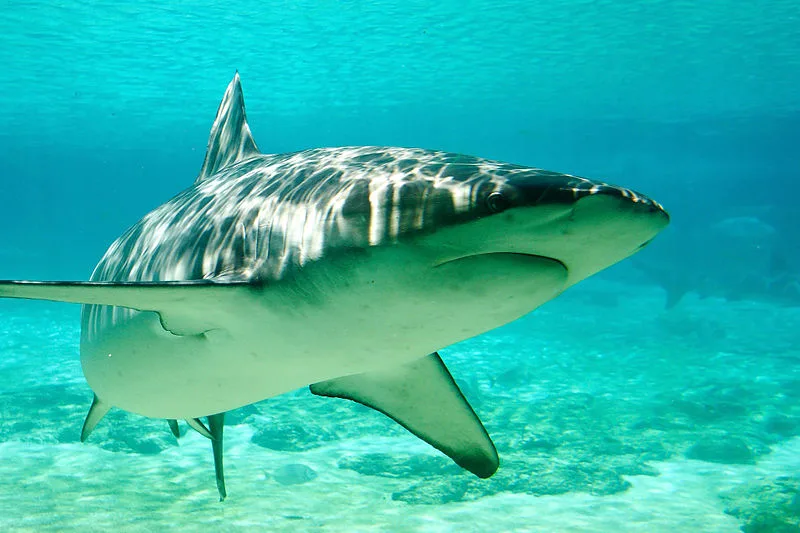
The Dusky Shark (Carcharhinus obscurus) is one of the biggest members of its family, weighing up to 160 pounds. It has a maximum length of 4.2 meters (14 feet) and a weight of 347 kg (765 pounds). Females are larger than males.
The slender, streamlined form of this shark has a very broad snout that is no longer than the width of the mouth. The nostrils are preceded by small flaps of skin that have not yet developed. The eyes are medium in size and circular in shape, with nictitating membranes (protective third eyelids) to protect them from injury.
The mouth has very short, subtle furrows at the corners and contains 13-15 (typically 14) tooth rows on either side of both jaws.
The upper teeth are broad, triangular, and oblique. They have strong coarse serrations. The lower teeth are narrower and upright with finer serrations. There are five pairs of gill slits that are fairly long.
Dusky Sharks are often confused with the other requiem shark species, like Silky Sharks, Sandbar Sharks, and Galapagos Sharks. The Dusky Shark is the hardest to tell apart from the rest. Its first dorsal fin is set further back than the free tips of its pectoral fins, and its other fins are proportionally smaller and swept back.
Dusky Shark habitat
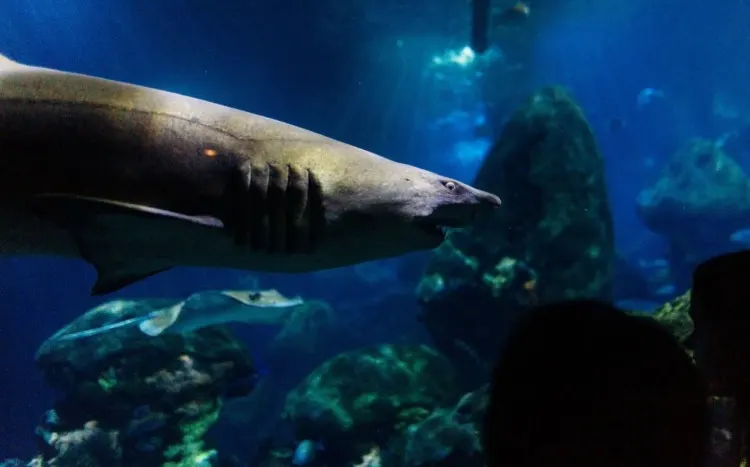
Dusky Sharks are year-round residents of coastal areas, showing up in inshore bays to the outer continental shelf and adjacent oceanic seas. This species’ adults generally avoid regions with low salinity levels and seldom enter estuaries.
Along the east coast of the United States, nursery grounds have been found in shallow inshore waters. Nursery grounds have also been discovered off the southwest coast of Australia.
The Dusky Shark is found in both tropical and temperate waters, making it a truly global species. These species migrate across broad areas, ranging from hundreds of kilometers to thousands of kilometers in each migration event. Animals move north in the summer and south in the winter in the western Atlantic and eastern Pacific.
Dusky Sharks migrate north in the austral winter-spring and south in the austral summer-autumn, respectively, in South Africa and Australia. They are known to be split into groups based on size and gender.
See Related: Black Tip Sharks: Are They Endangered?
Dusky Shark diet
Dusky Sharks are most often found in near-shore bays, on the outer continental shelf, and in adjacent oceanic seas. They are generally active during the day and congregate offshore waters, but they may be seen at the coast where they go for food.
These species migrate long distances, moving via the seas to Australia and South Africa. Dusky Sharks are divided into genders and sizes, with the biggest ones traveling north or south according to the season of the year.
The diet of these creatures consists largely of bony fishes, squid, octopus, crabs, oysters, seals, dolphins, other sharks, rabbits, and seabirds. Bony fish are their favorite. They are not in danger of extinction since hunting them is prohibited in many countries. They have a voracious appetite and can devour 60 pounds (about 25 kg) of food in one sitting.
Dusky Sharks are social creatures. They usually swim in groups. Many things present a potential predator to them, including killer whales, blue sharks, tuna, sea lions, and humans.
Their babies are called pups. They need parental care. Dusky Sharks mate during the summer and give birth to their pups in the spring. They can grow up to 10 feet long and weigh about 450 pounds.
Dusky Shark is not endangered
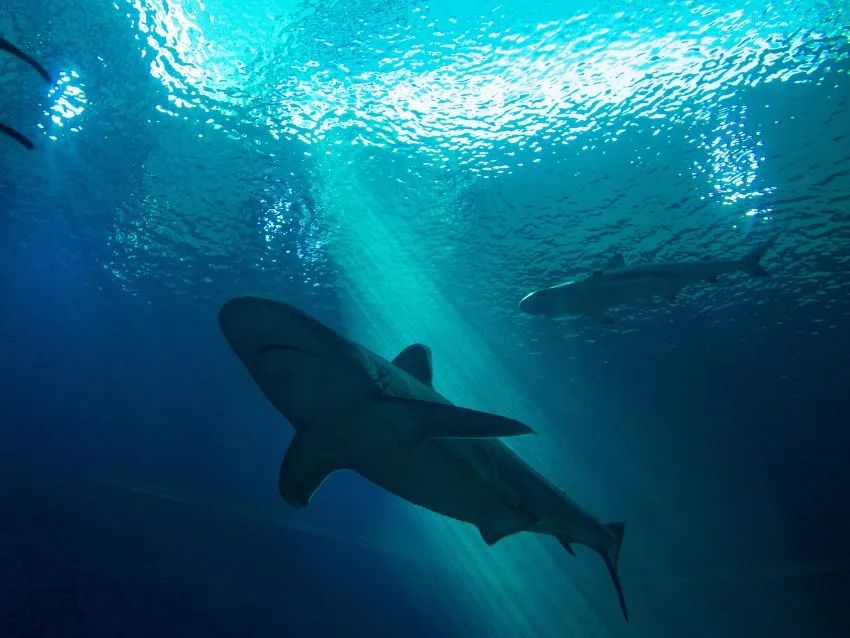
Sharks from around the world face different threats. The Dusky Shark is one of the most threatened sharks, with declines in their population of up to 99% in the Atlantic Ocean and 75% in the Indian Ocean.
Some sharks migrate to the Americas, Africa, Australia, and parts of Asia. The IUCN lists the Dusky Shark as Vulnerable to extinction globally. There are no international protections for this migratory species. Its populations are being caught at unsustainably high rates for their fins.
There were a lot of sharks caught in the past few years, but not as many Dusky Sharks. Scientists think this is because there are fewer of them. There are no ways to protect them because they live in the ocean. This animal has been under a lot of pressure since the 1970s. The increased pressure may be pushing it to the edge of collapse now.
The lack of management, unsustainable fishing practices, and low reproduction rate of the species means it needs to be better managed. Putting it in Appendix II is the first step in achieving the protection needed.
Conservation
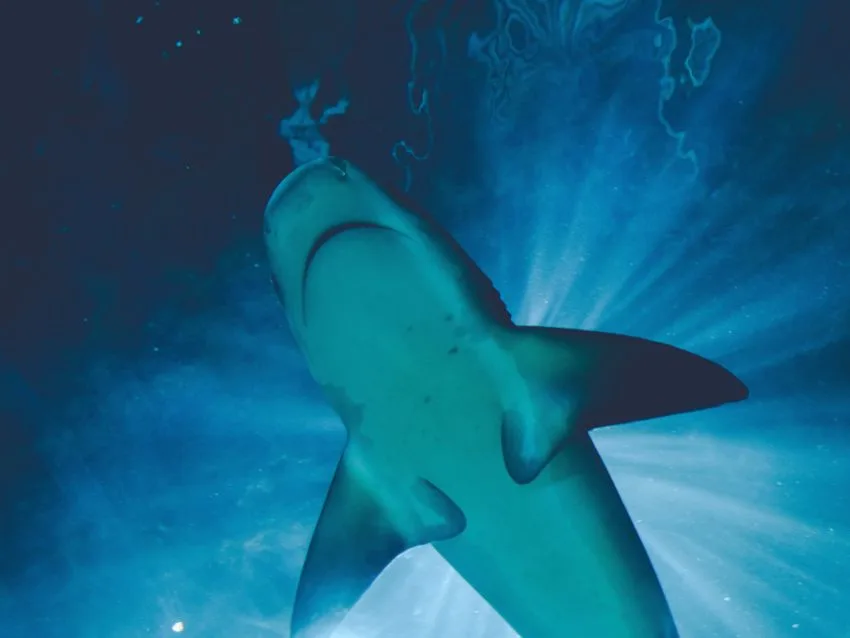
Threats
The trade of shark fins has resulted in significant losses in Dusky Sharks. It is estimated that about ¾ million of these sharks are killed for shark fin trade every year.
Dusky Sharks are also victims of commercial and recreational fishing. These sharks get caught in shark nets often. This is causing a decline in their population, especially in Australia and South Africa. Aside from this, young Dusky Sharks can be predated by larger sharks like bull sharks.
The Dusky Shark is also taken for its oil, and the skin is made into leather. Because of the ‘fight’ the Dusky Shark gives when hooked, it is prized in sport fishing.
Conservation efforts
Due to the declining numbers of Dusky Sharks off the United States coast, commercial fishing of this species is forbidden on the US coasts. Sportfishing, however, is allowed.
The Dusky Shark has yet to receive no protection in other parts of the world.
The dusky shark has yet received no protection in other parts of the world.
Organisations
Oceana

Oceana is the largest international organization focused only on ocean conservation, protecting marine ecosystems and endangered species such as the Dusky Shark.
Conclusion
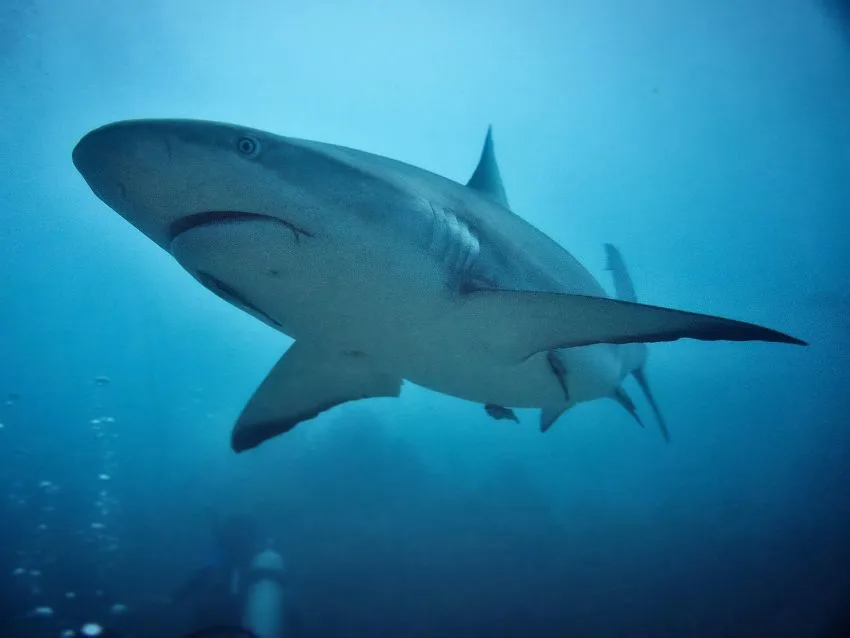
Dusky Sharks are a type of shark that is often mistaken for whale sharks. They can be found in the Pacific and Atlantic oceans, as well as in the Indian Ocean.
Dusks prefer cooler waters because they need to keep their body temperature low due to an insulating layer of blubber under their skin.
This species feeds on fish like herring and mackerel and occasionally squid or octopus if it’s lucky enough to find them! Its population has been decreasing since 2000, but it’s hard to tell exactly how many Dusky Sharks are left out there, so we don’t know whether or not this species is endangered yet.
The IUCN classifies these species as Near Threatened. They are occasionally caught for their liver oil, meat, and fins, although international regulation of Dusky Shark fishing has now been implemented. Dusky whaling was formerly unlawful; however, it is now prohibited throughout the world.
FAQ
What is Dusky Shark?
The Dusky Shark is a dark gray or brownish fish that lives in the Atlantic, Mediterranean, and Black Seas. They are generally dark gray or brown with darker bellies. These species have enormous hearts that pump almost twice as much blood as smaller sharks’.
The two dorsal fins of a Dusky Shark have short spines that are positioned just behind the last free-fin ray, whereas others usually have one dorsal fin located near the tail end of their bodies, and some spiny dogfish species do not have any.
Dusky Sharks are most often captured in fishing trawls, particularly off the southeast Atlantic and central Mediterranean Sea – DLSO promotes sustainable management and healthy stocks of the species worldwide through the DSH fishery.
Would Dusky Shark make a good pet?
Dusky Sharks make outstanding pets. They are generally black or dark brown in color, with darker bellies, giving them a striking appearance. These species are among the most docile of all shark species, with only one reported fatality over 35 years.
Dusky Sharks are very curious, so they will inspect their surroundings or seek out food. They are relatively easy to train because they’re naturally curious and intelligent.
These predators will adapt to eating whatever is offered but do best with a high-quality diet that includes fresh seafood. They can even be trained to hand-feed.
Dusky Sharks thrive in huge enclosures with lots of running room and exploration space. They are most certainly not aggressive toward others of their own kind. Therefore they should be housed together.
Are Dusky Sharks endangered?
Dusky Sharks are believed to have no commercial value. They are not typically caught by fisheries, they can be found in deep water, and it is difficult for fishermen to see them in the depths of the ocean. Its population is unknown and slow-growing. As a result, it has been given the status of “data deficient,” which could lead to these species being classified as endangered if more data becomes available in future surveys.
Dusky Sharks are not commonly caught by humans, and it is believed they have no commercial value. Also known as Carcharhinus obscurus, they are considered among the least-threatened large sharks in the world. They can grow to about 9 feet (2.7 m) long and weigh up to 360 pounds (160 kg). They are indicators of healthy, normal marine ecosystems.
Dusky Sharks tend to stay far away from humans and human activity, so they do not typically interact with people or come into contact with them very often. Their diet mainly consists of fish, including mackerels, herrings, anchovies, and sardines.
Other Species Profiles
Related Resources
